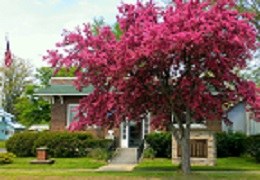History of the Library - Part 5

During the summer of 1925, Marcellus residents stood on the corner of Main and Burney Streets and gazed at their amazing new library building. It sat alone, somewhat squat and square, in the middle of a barren lot, looking a bit forlorn. Yet for the people of Marcellus, it must have been a most beautiful sight: the first time their library, started in 1895, had a home of its own.
Marcellus residents had, of course, watched the library grow on that spot for the past two years. They had seen the rich, red bricks define the walls, and watched the installation of the beautiful front doors, facing Main Street. The front steps with gracious cement walls that curved downwards invited them in.
They knew there was a basement library room that would have two bathrooms. They could see the tall windows on three sides which would let sunlight into the upstairs reading room. And there would be two more bathrooms on that floor!
Even before entering the library, some residents’ minds were turning toward landscaping, and it was not long before plants, grass and trees were planted on the lot.
The library roof was flat, with rainwater drained away through pipes that went down through the building and safely away to the street gutter. A short brick wall rose around the edges of the roof. On the Main Street side, in the middle of this short wall, was -- and still is -- a decorative ornament, called a finial, which added height and dignity to the building. It is a solid rectangular block, decorated in a rather classical style and topped by a rounded fan-shaped trim. The plaque on the front is decorated with two lamps, one on each side of a shield, and all united by a ribbon which announces the date when construction began, 1924.
No reference to this finial was found in library records. There was, however, a rather sizeable (compared to other charges) bill for “art stone” from the United Stone Company in Bellevue, MIchigan. Perhaps it was this company which created the finial from art stone, a mixture of cement and clay used for sculpture and decorative items.
The “crown” of the library building is certainly the eaves, which slope down from the upper walls, supported by strong white brackets. Originally, the eaves were covered with reddish-brown clay tiles, which interlocked to provide protection from rain and added a beautiful stateliness to the building.
There are no details in library files about the decision to use these tiles, or the cost and labor required to install them. Although the original clay tiles have been replaced, the library kept many of them, as mementos of the original building. On the back of some of the original tiles, the name of the manufacturer is imprinted in the clay: Ludowici-Celadon, Imperial Tile, Chicago. These imprints provide the only clue to where the tiles were made.
The story of the Ludowici roof tile company started in 1888, when the Celadon Terra Cotta Company was formed in Alfred, New York. The company expanded and added locations quickly over the next few years. A plant was opened in Chicago, Illinois, in 1893. In 1902 the Celadon company purchased the Imperial Brick Plant in New Lexington, Ohio. This company then became the largest clay roof tile plant in the United States.
Because of the processes required in firing clay tile, fire was an ever-present danger to the manufacturing facilities. In 1909, both the Alfred, New York and Chicago, Illinois plants were destroyed by fire. In 1914 a plant which had been opened in the town of Ludowici, Georgia, was closed and was consolidated into the New Lexington, Ohio facility. It is at this point that the name Ludowici was added to the company name.
Thus, when the architects and builders for the Marcellus Library were making their plans, they probably ordered the tiles for the eaves from the Ludowici-Celadon-Imperial plant in New Lexington, Ohio, though the stamps on the tiles continued to be labeled Chicago-Imperial Tile.
The Ludowici-Celadon company almost closed after World War 11. For a time they made nothing but ceramic cookie jars. Business picked up slowly and now they provide roofing in many styles and colors for buildings around the world. In 2014 the company, now known only as Ludowici, introduced the first recycled products that meet the performance levels of terra cotta roof tiles.
The Ludowici terra cotta tiles protected and beautified the library building for sixty years. They were removed when the library added its first extension in 1984. The tiles were replaced with green shingles which have also added color and protection to the library since that time. Some of the original tiles must have been destroyed or moved, but many were saved and still remain in library storage.
Now, in the summer of 2018, residents of Marcellus can come to the corner of Burney and Main Streets to see some of the original Marcellus Library terra cotta roof tiles, just as their ancestors did 93 years ago. The tiles will be on display outside the library during Bluegill Frolic days, Friday and Saturday, August 24 and 25.
There are several hundred original roof tiles available; they will be given away in return for a cash donation to the library.
The library will also be displaying some original tiles which have been transformed by paint and creativity into decorative items useful in homes and yards. Examples of tiles turned into candle holders, address markers, wall decorations, and other useful items will be on display during Bluegill Frolic, honoring the long life of the original library tiles with updated uses and colors.









